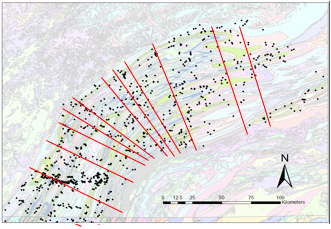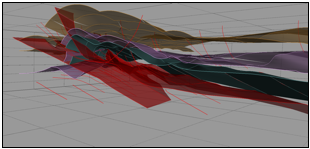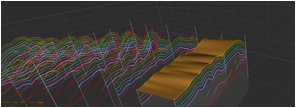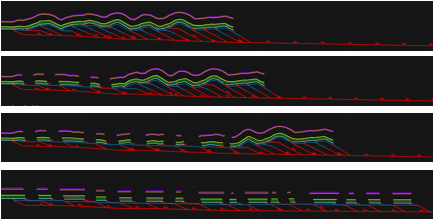Reports: UR851793-UR8: Fluid Evolution and Changes in Deformation Conditions During the Formation of the Central Appalachian Fold-and-Thrust Belt of Pennsylvania
Mark A. Evans, PhD, Central Connecticut State University
During the first two years of the grant, over 500 field sites were visited and 750 vein samples collected. At each site, we also collected all available structural data, including strike, dip, fault orientation and slip direction, joint and vein orientation, cleavage and pressure solution orientation data. Year three focused on compiling the data and preparing and analyzing the samples collected in years one and two.
The analytical work has been divided into several tasks. One task involved examining the fluid inclusions and structural history of the Devonian shale sequence, including the Marcellus shale. This work was published in AAPG Bulletin in November, 2014 and had three undergraduate student co-authors. The results of this part of the study greatly enhance the understanding of natural fracture formation in the Middle Devonian shale sequence. By compiling all of the joint and vein orientation data collected from all sites to date, a regional picture of fracture distribution has been created. The fractures suggest that an initial 325° directed shortening event affected the entire central Valley and Ridge province. Then, there was a clockwise rotation of shortening to the east and a counterclockwise shortening to the west. These results were presented by the PI at the NE section meeting of the GSA in March 2015.
Related to this task, one student did a detailed study of quartz vein morphology, fluid inclusion history, and SEM-CL (cathodoluminesence) response. The results were impressive in that in many veins, particularly those with a blocky texture, CL-response can be related to the fluid inclusion homogenization temperatures from the quartz. High-temperature (~175-200 °C) quartz typically has a bright white CL-response, while low temperature (~125-150 °C) quartz has dull-gray CL-response. Interestingly, CL-response of fibrous quartz veins was typically muted. We are in the process of investigating the cause of this CL-response. One student presented the results of this at the NE section meeting of the GSA in March 2015.
Another task has been to construct a series of balanced cross sections around the central Pennsylvania salient. Evans is the primary on this task, but in the past year, two students also participated. We have now completed 25 regional cross sections (Figure 1). Nine shorter sections across the Nittany anticlinorium were constructed by a student. He then created a 3-D model of the anticlinorium in Midland Valley's 3D Move computer program (Figure 2). A second student created a retrodeformed section of one of the eastern cross-sections in Move (Figure 3). All of the cross sections will be digitized in Move and used to create a 3-D regional structural model. The final stage of this analysis will be to integrate the retrodeformed sections into a model of thrust propagation. Two students presented posters on these topics at the NE section meeting of the GSA in March 2015.
By integrating fluid inclusion microthermometric data that provides fluid trapping pressure temperature with the structural cross sections, we find that the regional variation in structural style across the region may be related to the distribution of syn-tectonic loads during deformation. Ion addition, the pressure and temperature conditions in any one structure may vary significantly during deformation as fold structures grow. Currently, two students are working on this task, one student is doing a detailed analysis of the fluid history on the Berwick anticline, and another student is working on the Broad anticline. Both structures are in the eastern Valley and Ridge, province.
The third task involves a fluid inclusions and stable isotopic study of calcite veins in the Siluro-Devonian and Cambro-Ordovician carbonate sequences. Host rock and vein samples were collected from sites across the southern Valley and Ridge province. Thin sections were described, fluid inclusion microthermometry done, and oxygen and carbon stable isotopes data run at the Yale Earth System Center for Stable Isotopic Studies. Results to date indicate that the calcite vein isotopic signature varies between vein sets, structural setting, and stratigraphic level. The data indicate that much of the control on fluids within the carbonate units is related by local fracture and fluid connectivity, which is in turn related to structural setting. One student did a detailed analysis of isotopic data from the Siluro-Devonian sequence in the Nittany anticlinorium in southern Pennsylvania, and another student did a detailed analysis on the isotopic data from the Cambro-Ordovician sequence in the Nittany Anticline in central Pennsylvania. The two students presented their results at the NE GSA meeting in March 2015.
In the next year of the grant, we will continue to work on cross section construction, fluid inclusions microthermometry and stable isotope analyses.
Figure 1. Location map
Figure 2. SEM-CL image (top) of quartz vein (bottom) showing response from high temperature (light-gray) and low temperature (dark gray) quartz
Figure 3. 3-D structural model of the Nittany Anticline in central Pennsylvania.
Figure 4. 2-D retrodeformation of a cross section from eastern Pennsylvania.
















